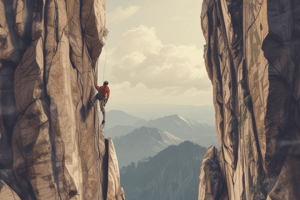Podcast
Questions and Answers
What is a key safety precaution in mountaineering?
What is a key safety precaution in mountaineering?
- Wearing fashionable climbing gear
- Having basic knowledge of knots, belaying, and rappelling (correct)
- Regularly checking weather forecasts
- Going on solo climbs
Which type of climbing requires ropes, crampons, and an ice axe?
Which type of climbing requires ropes, crampons, and an ice axe?
- Rock climbing
- mountaineering
- Ice climbing (correct)
- Mixed climbing
What is a common safety precaution to take before starting a climb?
What is a common safety precaution to take before starting a climb?
- Not checking the condition of gear
- Avoiding physical conditioning
- Ignoring weather monitoring
- Ensuring all gear is in good condition (correct)
What is a characteristic of big walls climbing?
What is a characteristic of big walls climbing?
What is the primary purpose of the buddy system in mountaineering?
What is the primary purpose of the buddy system in mountaineering?
What is the main difference between free climbing and aid climbing?
What is the main difference between free climbing and aid climbing?
Which climbing technique involves placing protection in the rock itself as you ascend?
Which climbing technique involves placing protection in the rock itself as you ascend?
What is free solo climbing?
What is free solo climbing?
Which of the following techniques is useful for scaling steep, overhanging rocks?
Which of the following techniques is useful for scaling steep, overhanging rocks?
What is one important aspect of trad climbing that distinguishes it from other techniques?
What is one important aspect of trad climbing that distinguishes it from other techniques?
Flashcards are hidden until you start studying
Study Notes
Introduction
Mountaineering is a diverse and complex activity that involves scaling peaks using various techniques while maintaining safety standards. This article will delve into the intricacies of mountaineering, exploring climbing techniques, essential safety measures, and different types of climbs.
Climbing Techniques
In mountaineering, several climbing techniques are used depending on the terrain, weather conditions, and individual preferences. Some common methods include:
-
Traditional Climbing: Also known as "trad" climbing, this technique relies on placing protection in the rock itself as you ascend. This method requires strong knowledge of rock climbing skills, including placing cams, nuts, and hexes, as well as building anchors at the top of pitches.
-
Free Climbing: Free climbers ascend the mountain without any additional support apart from ropes and quickdraws attached directly to the rock. This requires advanced skill, strength, and mental focus. The term "free solo" refers to climbing without ropes at all, which is extremely dangerous and generally discouraged due to the high risk of injury or death.
-
Aid Climbing: Aid climbing involves using specialized equipment like pitons, hammerless camming devices, and ladders to progress upward. This technique is particularly useful for scaling steep, overhanging rocks where traditional climbing may prove difficult or impossible.
Safety Measures
Ensuring safety in mountaineering is crucial due to the inherently hazardous nature of the activity. Key safety precautions include:
-
Proper Training: Develop the necessary skills and knowledge required for climbing, including understanding the basics of knots, belaying, and rappelling. Many organizations offer courses and workshops for beginners.
-
Physical Conditioning: Build strength and endurance through regular exercise, ensuring that you are physically prepared for the demands of mountaineering.
-
Equipment Check: Always ensure that all gear is in good condition before starting a climb. Regular maintenance and checks can prevent accidents caused by faulty equipment.
-
Weather Monitoring: Stay updated on weather conditions and avoid climbing during periods of bad weather, such as storms or high winds, which increase the risk of accidents.
-
Communication and Planning: Share details of your planned climb with someone not participating, including estimated start times, expected return times, and emergency contact information. Carry communication devices (such as satellite phones or radios) and know how to use them effectively.
-
Buddy System: Never climb alone, always go with at least one other person who can assist if needed.
Different Types of Climbing
There are numerous types of climbing, each with its own challenges and requirements:
-
Alpine Climbing: This focuses on ascending large mountains, often involving glaciers, snowfields, and steep rock sections. Alpine climbing typically requires ropes, crampons, and an ice axe, along with suitable clothing and shelter for extended stays at high altitudes.
-
Big Walls: These refer to large vertical faces that require multiple pitches to climb, sometimes taking several days or even weeks to complete. Big walls demand extensive planning, logistics management, and teamwork.
-
Multi-pitch Climbing: Typically involving roped sections separated by belay points, multi-pitch climbing requires careful planning, efficient use of gear, and communication between climbers to ensure a successful ascent.
-
Ski-mountaineering or Skimo: Also known as "rando" (short for "randonee"), this discipline combines skiing and climbing techniques, often in alpine environments. It involves skiing uphill using specialized touring equipment and then descending using alpine-style ski gear.
In conclusion, mountaineering is a thrilling and challenging activity that requires careful planning, skill development, and safety precautions. By understanding various climbing techniques, safety measures, and types of climbs, aspiring mountaineers can embark on their adventure with greater confidence and knowledge.
Studying That Suits You
Use AI to generate personalized quizzes and flashcards to suit your learning preferences.





